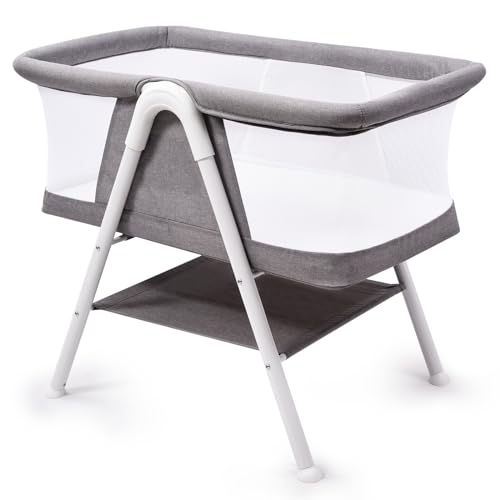11 Ways To Totally Block Your Bedside Bassinet
The Ultimate Guide to Choosing a Bedside Bassinet: Safety, Comfort, and Convenience
Introduction
As new parents enter the exciting yet complicated world of childcare, one vital item that typically tops the list is a bedside bassinet. These spaces act as a safe sleeping location for newborns while permitting parents to keep close proximity throughout the night. With a myriad of alternatives readily available on the marketplace today, comprehending the features, advantages, and factors to consider for a bedside bassinet can make a significant difference in the total parenting experience.
This article will check out the various kinds of bedside bassinets, security standards, essential features to consider, and some frequently asked questions to help you make an informed decision.
What is a Bedside Bassinet?
A bedside bassinet is a sleeping space developed for newborns and infants, usually used for the very first couple of months of a baby's life. It is normally smaller than a crib and offers the benefit of being positioned next to an adult bed, making it possible for parents to tend to their babies quickly throughout nighttime.
Types of Bedside Bassinets
There are a number of types of bedside bassinets available, each created with distinct features and advantages:
Co-Sleeping Bassinets: These are designed to attach firmly to the side of the parent's bed, permitting easy access during nighttime feedings and soothing without completely co-sleeping.
Standalone Bassinets: These are free-standing variations that sit beside your bed but do not connect. While they use up more space, they can in some cases use a bigger sleeping location.
Travel Bassinets: Lightweight and portable, these bassinets are created for families on the go. They can be folded or taken apart quickly, using convenience while traveling.
Convertible Bassinets: Some designs can transform into cribs or playards, extending their life expectancy and making them a more economical option.
Benefits of Using a Bedside Bassinet
Going with a bedside bassinet can provide many advantages, including:
Convenience: Parents can easily access their baby during the night for feeding, reassuring, or diaper changes without rising.
Safety: Bassinets are developed specifically for infants, frequently sticking to safety guidelines that help minimize the danger of Sudden Infant Death Syndrome (SIDS).
Comfort: Babies can feel secured with their parents close by, promoting a sense of security that is favorable to much better sleep.
Space-saving: Bedside bassinets are typically compact and easy to fit in smaller bed rooms.
Key Safety Features to Consider
When picking a bedside bassinet, guaranteeing security is paramount. Here are a couple of vital security features to think about:
Stable Base: Ensure the bassinet has a strong structure that can not tip over easily. Inspect that wheels lock into location to avoid movement.
Breathable Fabrics: Look for materials that enable air blood circulation to minimize the threat of suffocation.
Height Adjustability: A bassinette that adjusts to the height of your bed can boost security and benefit.
No Drop Sides: Select designs that do not have drop sides, as they can present a danger of the baby falling out or getting caught.
Certification: Always ensure that the bassinet abides by safety standards set by recognized agencies like the American Academy of Pediatrics (AAP).
Extra Features to Look For
Aside from security, here are some extra features to consider when trying to find the best bedside bassinet:
Storage Space: Some bassinets feature integrated storage for essentials like diapers, wipes, and attire.
Rocking or Gliding Mechanism: This can assist soothe babies who have difficulty calming down to sleep.
Sound and Light Features: Some models include soothing noises, nightlights, or projections that can assist soothe infants to sleep.
Washable Components: Make sure removable covers and sheets are machine washable for easy cleansing.
Picking the best bedside bassinet is a crucial choice that can exceptionally influence the early parenting experience. By comprehending the different types readily available, their benefits, necessary security features, and additional conveniences, parents can make an educated choice to make sure both their baby's comfort and security.
Eventually, the best bedside bassinet should deal with individual household requires while improving the bond between parents and their newborns during those precious very first few months.
FAQs about Bedside Bassinets
1. The length of time can I use a bedside bassinet for my baby?
The majority of bassinets are developed for infants approximately about 4 to 6 months, or till the baby can roll over, pull up, or surpass the weight limit defined by the maker (usually around 20-30 pounds).
2. Are bedside bassinets safe for co-sleeping?
While bedside bassinets offer close proximity, it's crucial to guarantee they're securely connected to the bed. Always follow guidelines for safe sleeping to reduce the threat of SIDS.
3. Can I use a bedside bassinet for a premature baby?
Yes, lots of bedside bassinets can accommodate early infants. However, it's vital to talk to a pediatrician for suggestions based upon your baby's particular needs.
4. What should Bedside Cot For Easy Night Feeding look for in terms of bed mattress safety in a bedside bassinet?
Ensure that the mattress fits securely versus the sides of the bassinet with no gaps. The mattress should be firm and covered with a fitted sheet to reduce the danger of suffocation.
5. Exist any particular cleansing instructions I should follow?
Most bassinets have detachable covers that can be washed. Constantly follow the manufacturer's instructions for cleansing and preserving the bassinet.
By resolving these concerns, parents can browse the decision-making process concerning bedside bassinets more successfully, making sure safety and convenience as they invite their youngster into the world.
